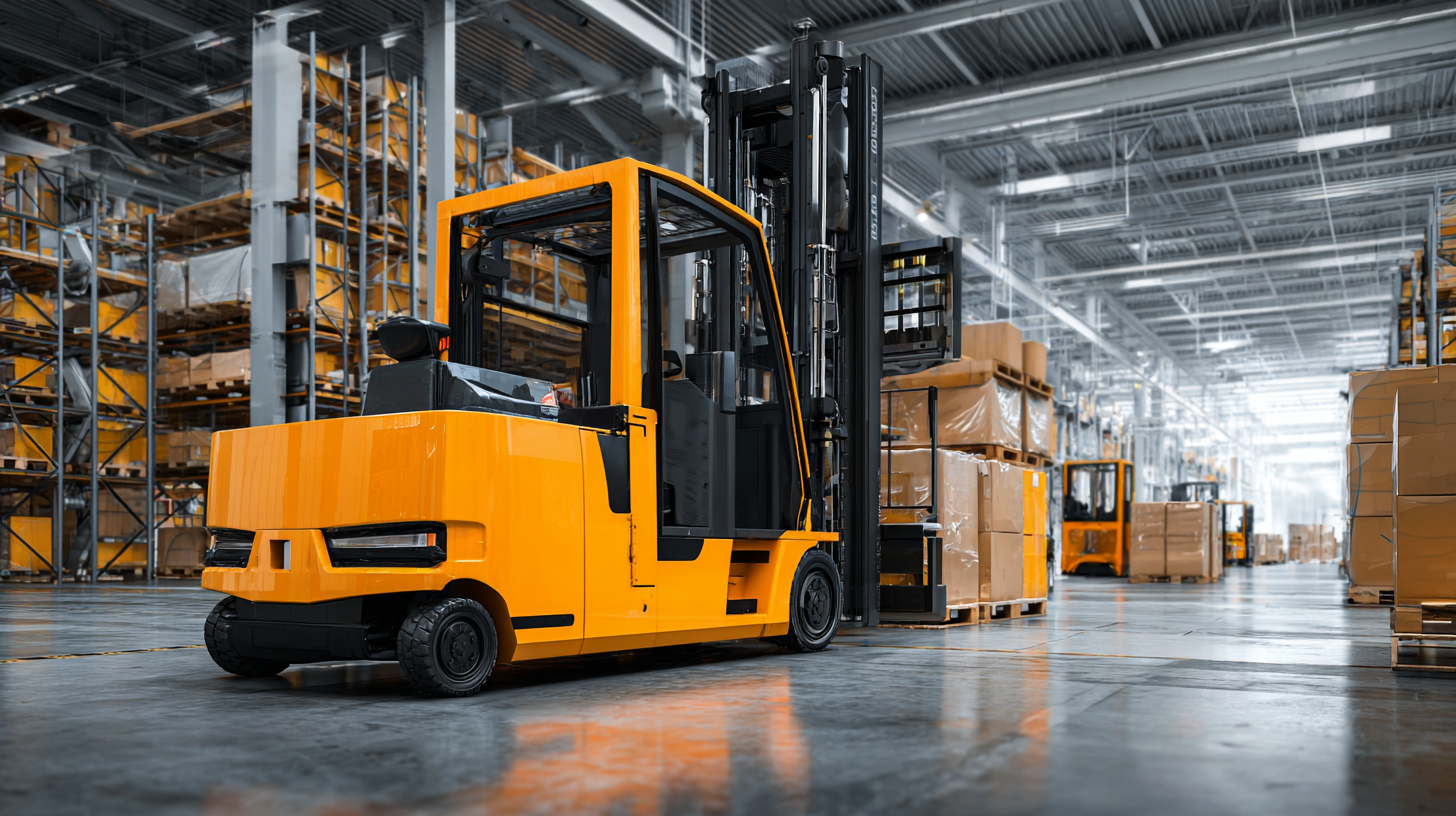Benefits of Optimizing Your Warehouse with Best Handling Equipment
In the fast-paced world of logistics and supply chain management, the significance of optimizing warehouse operations cannot be overstated. Research indicates that the effective use of handling equipment can lead to an increase in productivity by up to 30%, while also minimizing operational costs by approximately 20%. Best handling equipment, such as automated storage systems and advanced pallet jack technologies, not only enhances the speed and accuracy of order fulfillment but also contributes to a safer work environment—reducing workplace injuries by over 40%.

As businesses strive to meet growing consumer demands and navigate the complexities of e-commerce, investing in the right handling equipment has become a crucial strategy for improving efficiency and scalability in warehouse operations. This blog will explore the myriad benefits associated with optimizing warehouse processes through the innovative use of handling equipment.
Benefits of Investing in Advanced Material Handling Solutions for Warehouses
Investing in advanced material handling solutions for warehouses can significantly enhance operational efficiency and reduce costs. Modern equipment, such as automated guided vehicles (AGVs) and conveyor systems, streamlines the flow of goods, allowing for faster processing and shipment. By minimizing manual handling, these solutions not only boost productivity but also mitigate the risk of employee injuries associated with traditional lifting methods. This not only improves workplace safety but also fosters a more positive environment for workers.
Moreover, advanced material handling systems integrate seamlessly with warehouse management software, providing real-time tracking and inventory management. This integration enables warehouse operators to better manage stock levels, forecast demand, and adjust operations accordingly. The ability to analyze data from these systems empowers businesses to make informed decisions, optimize space usage, and enhance order accuracy. Ultimately, investing in these technologies not only streamlines warehouse operations but also positions companies for growth in an increasingly competitive market.
Data-Driven Insights: How Optimized Warehousing Reduces Operational Costs by Up to 20%
In today’s fast-paced logistics environment, optimizing warehouse operations with advanced handling equipment is more than just a necessity; it’s a strategic move that can significantly reduce operational costs. Implementing data-driven insights reveals that companies can achieve savings of up to 20% through optimized warehousing solutions. This is largely facilitated by the integration of artificial intelligence and digital technologies, which streamline processes, enhance decision-making, and boost overall efficiency.

Artificial intelligence is transforming operations management by automating routine tasks and providing predictive analytics that minimize delays and improve resource allocation. Businesses leveraging AI and machine learning not only optimize their inventory management but also enhance customer satisfaction through quicker order fulfillment. As the market for AI in logistics is projected to grow significantly, the emphasis on adopting sophisticated tools such as digital twins is becoming apparent. These technologies enable companies to simulate various operational scenarios, allowing for better planning and increased warehouse productivity. In this age of digitalization, adopting state-of-the-art handling equipment and data-driven insights is critical for companies aiming to thrive in a competitive landscape while maintaining cost efficiency.
Enhancing Productivity: The Role of Automation in Reducing Warehouse Processing Times
In today's fast-paced supply chain environment, optimizing warehouse operations is essential for enhancing productivity. A key component of this optimization is the integration of best handling equipment, particularly automation technologies. By employing automated systems such as conveyor belts, robotics, and RFID tracking, warehouses can significantly reduce processing times. Automation minimizes human error, accelerates sorting, packing, and shipping processes, and allows for real-time inventory management. This efficiency not only speeds up order fulfillment but also enhances overall accuracy in inventory control.
Furthermore, automation empowers warehouse staff to focus on higher-value tasks by taking over repetitive and time-consuming activities. For instance, automated guided vehicles (AGVs) can transport goods throughout the warehouse with precision, allowing workers to dedicate their time to strategic roles such as quality assurance and customer service. This shift not only elevates employee satisfaction but also contributes to a more agile and responsive warehousing operation. Ultimately, leveraging automation in handling equipment not only streamlines workflows but also positions businesses to meet the increasing demands of customers with greater efficiency and reliability.
Benefits of Optimizing Your Warehouse with Best Handling Equipment - Enhancing Productivity: The Role of Automation in Reducing Warehouse Processing Times
| Equipment Type | Processing Time Reduction (%) | Increase in Productivity (%) | Cost Savings ($) | Return on Investment (ROI) |
|---|---|---|---|---|
| Automated Guided Vehicles (AGVs) | 30% | 25% | $50,000 | 150% |
| Conveyor Systems | 20% | 15% | $30,000 | 120% |
| Warehouse Management Software (WMS) | 25% | 20% | $40,000 | 130% |
| Picking Robots | 35% | 30% | $70,000 | 160% |
| Automated Storage and Retrieval Systems (ASRS) | 40% | 35% | $100,000 | 175% |
Quality Control and Customer Satisfaction: The Impact of Proper Handling Equipment on Global Trade
In today's competitive global marketplace, the significance of quality control and customer satisfaction cannot be overstated. Proper handling equipment plays a critical role in ensuring that products move smoothly through the supply chain. From the initial stages of procurement to the final delivery, having the right tools not only enhances efficiency but also minimizes the risk of damages and delays. This, in turn, boosts customer confidence and promotes repeat business.
To optimize your warehouse and ensure quality control, consider the following tips: First, invest in ergonomic handling equipment that reduces strain on workers while enhancing productivity. This not only leads to higher quality outputs but also fosters a safer working environment. Second, streamline your processes by incorporating technology that aids in tracking and managing inventory more effectively. Automation can significantly reduce human error, ensuring that customers receive their orders accurately and on time.
Moreover, cultivating good relationships with suppliers is essential for seamless operations. By aligning with suppliers who adhere to quality standards and efficient production practices, you can achieve a more consistent product flow. This collaboration is crucial for maintaining customer satisfaction, as it directly impacts the quality of the goods delivered in cross-border trade.

Future-Proofing Your Warehouse: Trends and Innovations in Handling Equipment for Global Market Success
In the rapidly evolving global market, optimizing warehouse operations through innovative handling equipment is crucial for future-proofing businesses. Recent trends reveal that the demand for advanced logistics solutions is escalating, with an average annual growth rate of 191% in logistics sector innovation. Companies are leveraging digital transformation, not only to streamline their existing warehouse networks but also to enhance flexibility and on-site presence in operations. This shift allows logistics providers to respond more adeptly to the needs of diverse industries such as automotive, retail, e-commerce, healthcare, and high-tech manufacturing.
A noteworthy example is Armlogi Holding Corp.'s recent public listing, which signifies the increasing importance of cross-border e-commerce logistics. As enterprises strive for global market success, the integration of cutting-edge technologies like automated guided vehicles (AGVs) is gaining traction, ensuring operational efficiency and accuracy. The 2023 Global Unmanned Forklift Innovation Forum highlighted significant developments in this sector, reinforcing the idea that logistics providers must stay ahead by continually adapting and embracing innovative handling equipment. The movement towards digital logistics solutions reflects a broader trend where companies are increasingly recognizing supply chain efficiency as a pivotal factor in achieving competitive advantage.
